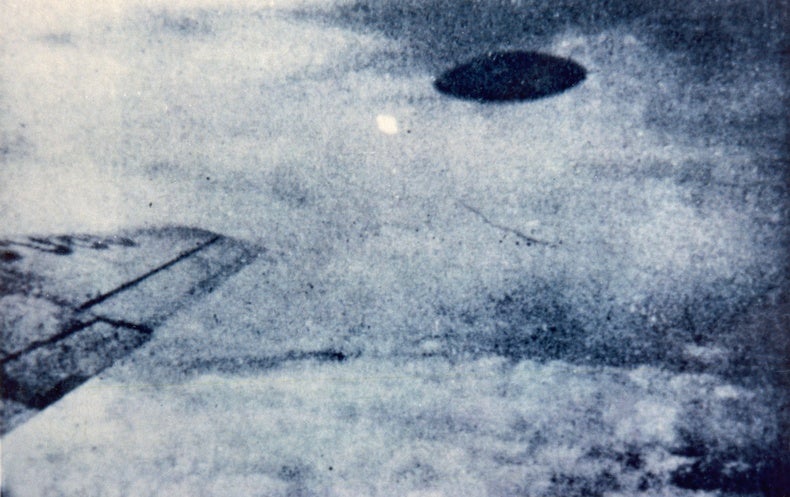What We Can Learn from Studying UFOs

In his book Childhood’s End, Arthur C. Clarke tells a story of a peaceful alien invasion of Earth that comes at the expense of humanity’s unique identity and culture. A report to Congress from the Pentagon and various intelligence agencies about sightings of unidentified flying objects (UFOs) by military personnel is scheduled to be made public shortly. The report reportedly concludes that some of the UFOs are likely real objects whose nature cannot be assessed with any confidence.
Most likely, the reported objects have mundane explanations, but we need better evidence to be sure. If they do represent alien technology, UFOs could potentially be robotic—autonomous equipment that follows a blueprint crafted by an intelligent species beyond Earth. They might even be self-replicating machines, as envisioned by the polymath John von Neumann.
Our current technology evolves exponentially on a timescale of a few years. The devices we use today would have seemed impossible a century ago (Clarke is famously known for the statement that “any sufficiently advanced technology is indistinguishable from magic”). Global Wi-Fi connectivity and the internet revolutionized human behavior in recent decades, and so will artificial intelligence, robotics and genetic engineering in future decades. Since most stars formed billions of years before the sun, it is conceivable that technological civilizations that emerged around them had more time to develop their science and technology than we did, and created equipment that represents our future and would appear magical to us now. This hardware could be so advanced that it would look to us as an approximation to God. When such equipment visits us, the encounter would echo our childhood experience of not fully understanding the actions of a higher power looking over our shoulders.
The possibility that the Pentagon UFOs are humanmade can potentially be excluded by identifying behavior that cannot be reproduced by our most advanced equipment. We know our technological limits because any advance that goes well beyond them would have introduced major commercial or military benefits and would have been represented in the consumer market or on the battlefield.
Nevertheless, most people might choose to ignore the Pentagon report and maintain an attitude of business as usual. My daughter told me explicitly that she will not miss her routine soccer match on the day that the report is made public, irrespective of its content. At a recent forum about my popular-level book Extraterrestrial and new textbook Life in the Cosmos, I was asked how long humans could ignore extraterrestrial intelligent life. I replied: “Humans may choose to remain ignorant forever. They can refuse to recognize a reality that does not flatter their ego, like the simple idea that we are not the smartest species that in the Milky Way.”
But reality does not care whether we ignore it or not. The existence of neighbors is not altered if we close the curtains on our windows and disregard them. The Pentagon has access to much more data than it releases to the public. Its report is expected to say that the reality of some UFOs is beyond doubt but that their nature requires further study. It is therefore an opportune time for the scientific community to take a closer look at UFOs by collecting and analyzing new data with the finest instruments and computers in a controlled setup. The new data can be obtained by measurement devices with capabilities far exceeding the equipment that provided past UFO data.
A fresh scientific study that offers reproducible evidence for UFO sightings and resolves their nature would demonstrate the power of science in answering a question that is clearly of great interest to the public. Finding a conclusive answer on the basis of open data will enhance the public’s confidence in evidence-based knowledge. Currently, the UFO mystery surrounding the expected inconclusive interpretation of the Pentagon report will fuel unsubstantiated speculations. A decisive scientific experiment holds the promise of clearing up the fog.
The required instrumentation will likely involve state-of-the-art cameras on wide-field telescopes that scan the sky. The data stream would be processed by an advanced computer system that will store only the essential variable features. The focus on near-field aerial phenomena that move fast across the sky is different from astronomical surveys of distant sources, such as the upcoming Legacy Survey of Space and Time (LSST) on the Vera C. Rubin Observatory.
Irrespective of whether the origin of UFOs is terrestrial or extraterrestrial, we will learn something new and exciting from studying them scientifically. And it is not just the hardware that will interest us. It is the meaning behind its existence—the intent of those who manufactured it. A single UFO of extraterrestrial origin will inspire fear among humans that the aliens could be malevolent, as Stephen Hawking believed—but they could be benevolent as well. As in Childhood’s End, they could be to us as nurturing parents are to young children. Here’s hoping that if and when the time comes, we will learn that their intent is wise and well-meaning.
This is an opinion and analysis article; the views expressed by the author or authors are not necessarily those of Scientific American


